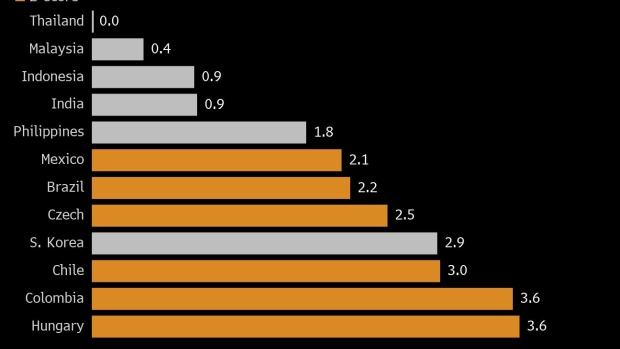Nov 27, 2022
Emerging-Market Bond Laggard Asia Is Primed for Rebound in 2023
, Bloomberg News

(Bloomberg) -- Emerging Asian bonds have trailed their developing-nation peers this year, but a turning point looks to be just around the corner.
Inflation pressures have begun to ease in many parts of the region, bringing forward predictions for a peak in interest rates. At the same time, positioning from overseas investors is historically light, leaving plenty of scope for inflows to increase. Finally, there’s growing optimism over an economic recovery in China into 2023, despite uncertainty over an increase in Covid protests.
Those positives are paving the way for a change in fortunes compared with the second half of this year, when emerging Asia bonds lagged their global counterparts on the perception Asian policy makers had been too slow to raise interest rates compared to their global EM peers, especially those in Latin America.
“For emerging-market Asia bonds in general, I think it will be a brighter six-to-12 months ahead into 2023 following two tumultuous years,” said Winson Phoon, head of fixed-income research at Maybank Securities Pte in Singapore.
The market is getting better visibility on the terminal fed funds rate and on the potential need for regional central banks to slow down on tightening, while “the tide on bond positioning may be turning favorable,” he said.
Emerging Asian bonds have handed dollar-based investors a loss of 2.8% since the start of July, according to an index compiled by Bloomberg. That compares with a drop of 0.4% for their counterparts in Europe, the Middle East and Africa, and a 1.6% gain in Latin America.
Easing Inflation
The main reason for optimism toward Asia lies in moderating inflation. Consumer-price gains have been below economists’ forecasts for at least three straight months in many of the region’s biggest economies, namely China, Indonesia, Taiwan and Thailand.
Bank Indonesia Governor Perry Warjiyo said Nov. 17 core inflation is set to peak early next year. The Bank of Korea on Nov. 24 forecast inflation to average 3.6% next year, weaker than it had predicted in August.
Inflation is coming under control in Indonesia and South Korea, “which is our top two local-currency debt calls in EM Asia,” said Jon Harrison, managing director for emerging-market macro strategy at macroeconomic forecasting consultancy TS Lombard in London.
Peak Rates
Anticipation of easing inflation is spurring central banks to signal the tightening cycle is almost over, indicating the peak will be lower in Asia than in the other emerging-market regions.
The policy rate in Thailand is still below pre-pandemic levels, while Malaysia’s is back where it was in March 2020. The benchmarks in those two countries along with Indonesia and India are less than 0.9 standard deviations above their five-year average. A similar gauge for Brazil, Mexico and the Czech Republic is above 2, while for Colombia, Hungary and Chile the figure is 3 or higher.
Fund Flows
There’s also room for a return of foreign funds after overseas investors cut their bond holdings across the region this year, with China, Indonesia, Malaysia and India all seeing net outflows.
DBS Bank Ltd. predicts that Indonesia -- which is often seen as a bellwether for the region -- will attract bond inflows of $3 billion to $7 billion in 2023, according to a note published this month. That follows net outflows of $9.6 billion this year, the most in Bloomberg data going back to 2010.
“Indonesia is attractive thanks to its higher yield, and in a more risk-positive environment, Indonesia’s bonds should benefit from increased portfolio flows,” said Rajeev De Mello, a global macro portfolio manager at GAMA Asset Management in Geneva.
China Recovery
The final catalyst that may propel Asian bonds is the long-awaited reopening of China, when the nation takes further steps to wind back its Covid Zero restrictions. The authorities have already begun to move in that direction, announcing earlier this month that travelers were required to spend less time in quarantine.
Preparation work has already begun for a meaningful re-opening of China so “Asia’s economic cycle remains very much alive,” said Min Lan Tan, head of the chief investment office for Asia Pacific at UBS Global Wealth Management in Singapore.
An increase in protests against Covid restrictions is adding an extra uncertainty. Demonstrations have taken place across China in recent days as citizens take to the streets and universities, venting their anger and frustrations on local officials and the Communist Party.
Swelling protests against China’s virus-induced curbs may even end up supporting asset prices by encouraging President Xi Jinping to accelerate the nation’s exit from Covid Zero, according to some market watchers.
What to watch this week:
- China will publish November manufacturing PMI on Wednesday, with investors looking to see the impact of the recent jump in Covid cases
- Bank of Thailand is forecast to raise its benchmark rate by 25 basis points on Wednesday, which would be a third straight increase
- Inflation data are due from Indonesia, South Korea and Poland this week, all of which will be scrutinized for any signs of a peak in price growth
- Poland, Brazil, Czech Republic, Turkey, Taiwan, India and South Korea will all report third-quarter gross domestic product
--With assistance from Srinivasan Sivabalan and Carolina Wilson.
(Updates to add reference to Covid Zero exit in final paragraph)
©2022 Bloomberg L.P.





